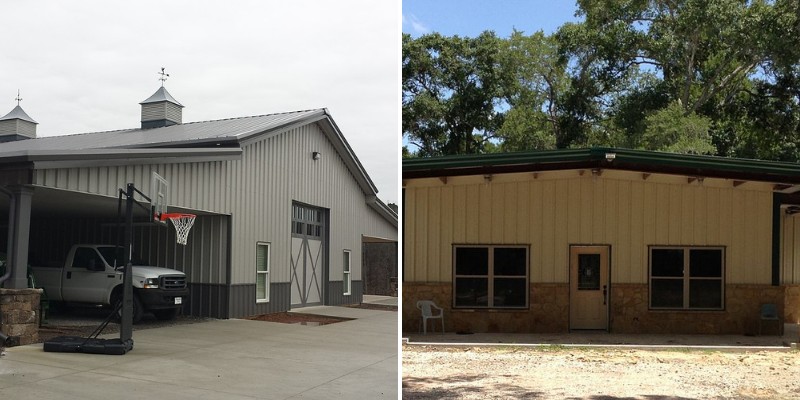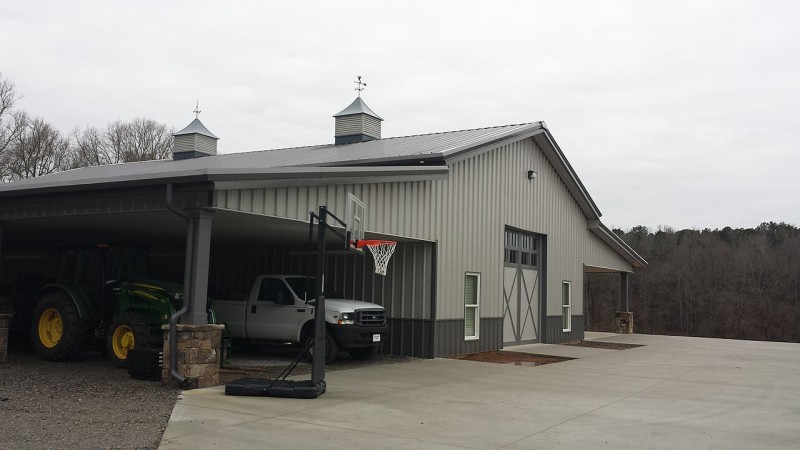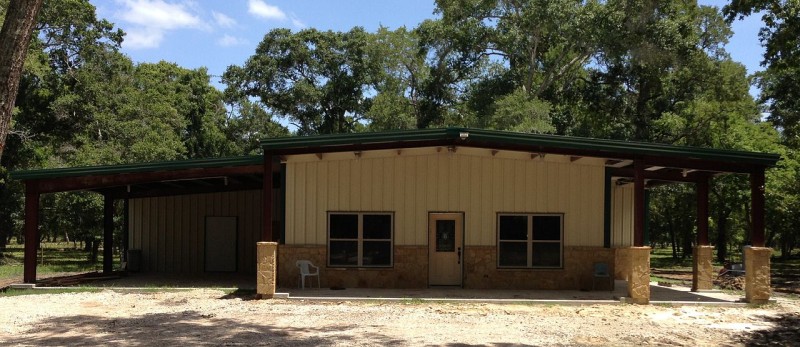Are you in the exciting planning stage of building a new house? Would you like it to be in a rural town, exuding country charm? Inside, do you picture a roomy layout? If so, a barndominium can fulfill your vision!

Its novel style has been gaining ground with home builders since 2016. That year, barndominium architecture got national press on the “Fixer Upper” TV show.
During one episode, the hosts converted a horse barn into a cozy home with chic rustic elements.
Should you jump on the bandwagon, too? As we discuss the pros and cons of a barndominium, you’ll learn whether this design is right for you.
What is a barndominium house exactly?
As the clever name implies, it’s a barn-shaped home with vaulted ceilings and an open floor plan. Also called a “barndo,” the interior has the modern amenities of a condominium.
Moreover, the spacious layout can house a separate area for work or hobbies. Homeowners vary by how they use it. Your options are countless! For instance, you can fashion a:
- workshop
- art studio
- game room
- haven for a beloved pet
- home office
- vehicle bay
Let’s now discuss some pros and cons of a barndominium:

Barndominium Advantages
1. Structural Integrity
The metal shell defies certain environmental hazards of wood-frame houses. For example, you’ll have no concerns with damaging termites, wood rot, mildew, and mold.
Your sturdy home will boldly stand up to pounding rain and thrashing winds. Plus, unlike wood, the metal frame repels fire.
Meanwhile, your maintenance and repair costs are lower than with wood construction. You may even save money on homeowner’s insurance.
2. Easy Customization
With a barndo, steel posts brace the ceiling, resulting in few load-bearing walls. Such architecture creates an open floor plan, giving you design freedom! You can appoint various living areas by grouping furniture, using partitions, and installing a staircase to a second level.
Would you like a gym at your fingertips? If so, picture an in-house fitness room featuring your chosen equipment and an awesome view.
Do you work from home? In that case, stake out your private office. Imagine earning a living from the comfort of your barndominium! In turn, you’re spared the effort of commuting, gaining more leisure time.
3. Eco-Friendly
As mentioned, barndos commonly have a steel frame and roof.
Steel is remarkably sustainable! It can be recycled endlessly, maintaining its strength and stability. The US recycles steel more than any other material, including plastic, paper, and glass. Often, steel mills will only accept scrap metal.
Since steel is reused constantly, it’s worth the energy to produce it. Meanwhile, steel manufacture yields less waste than other building materials. Moreover, this metal is certified under the Green Buildings Rating System.
4. Quick Construction
Generally, building a wood-frame home takes from seven to 12 months. Conversely, a barndo requires four to six months.
Either way, the timeline is roughly the same to pour a concrete foundation and finish the home interior. However, a barndo makes speedy work of erecting a frame and installing siding.
For a do-it-yourself project, you can buy a barndominium building kit. There are two types.
Basic Kit – contains a steel roof and frame, beams, and exterior walls. Assembly is straightforward and relatively easy to accomplish.
Turnkey Kit – has interior components, such as:
- drywall and insulation
- plumbing, HVAC, and electrical systems
- double-pane windows
- water and heat pumps
- concrete floors
- cabinets and countertops
Note – Do you plan to use a professional builder and subcontractors? If so, be sure to hire those specializing in barndominium construction.
5. Energy-Sparing
Probably, you’re wondering, “Are barndominiums energy efficient?” Yes, they can be.
First, install fiberglass and foam insulation. They’ll lower heat transfer through your roof and exterior walls.
As such, your house will better hold warmth during winter and cooled air in the summer. Furthermore, you’ll conserve natural resources, curbing your utility bills.
For the best results, affix fiberglass boards to the underside of your roof. Then, use spray foam insulation inside the wall cavities.
Additionally, install windows with low-E glass. The “E” stands for emissivity, the capacity of a surface to emit and radiate heat. Low-E glass has a clear, thin, insulating coating.
During winter, the glass reflects the sun’s infrared rays into your home, warming it. Then, in summer, the coating deflects solar heat from your house. Meanwhile, the open floor design of a barndo promotes air circulation.
Additionally, you can install solar panels on your roof, cutting energy consumption even more.
6. Money-Saving
The cost to build a barndo varies, depending on these factors:
- house size and location
- prices of construction materials
- the custom features you desire
- service or labor charges of those you hire
Still, you’ll pay less to erect a barndo than a traditional wood-frame home.
One way to save money is by forgoing an architect. Instead, shop online for a premade blueprint targeting your specific wants and needs.
One website featuring barndo blueprints is https://barndominiumplans.com/. Or, if you’re tech-savvy, consider buying house design software that renders 3D drawings.
Do you have solid experience in certain aspects of house construction? In that case, you can do the jobs for which you’re skilled, hiring a subcontractor for the others. With this strategy, you’ll still come out ahead financially.
7. Home Appreciation
Another concern you likely have is, “Do barndominiums hold their value?”
Yes, the worth of your barndo will likely increase over time. In the future, if you decide to sell your barndo, there are several factors in your favor.
- Barndo building companies are known for their high-quality construction. As such, barndos have a reputation for being sound and durable.
- Increasingly, more home buyers are seeking eco-friendly dwellings. They also like the design flexibility that comes with an open floor plan.
- Recent statistics show an upward trend in barndo home value.
When barndominiums first joined the real estate market, their resale data was scarce.
However, since 2016, barndos have gained popularity. In turn, more public resale records are available, showing a steady increase in home appreciation.

Barndominium Disadvantages
1. Financing Hurdle
Securing a mortgage for a barndo can be challenging. That’s because it’s not classified as a manufactured home.
For instance, a barndo lacks a solid chassis, enabling transport from a factory to a building site. Also, many mortgage lenders see barndo construction as a risky business venture.
Still, you can take steps to facilitate loan approval. First, approach a farm credit bureau or the financial institution where you bank.
Such creditors are most likely to be open-minded about your construction project. Then, before meeting with the loan officer, do the following preparation.
- Ensure you can afford a down payment of 20 percent of the total loan amount. Next, review your credit report and credit score. Since reporting errors are common, be sure to contest and correct any that appear.
- Hire an appraiser. They’ll assess the current worth of your chosen property and its future value after barndo completion.
- Gather your schematics and blueprint or 3D drawings.
- Do you intend to use subcontractors? If so, list those you’ve consulted and their respective estimates.
- Prepare a timeline, including when you expect to finish construction.
Then, bring all the above data to your appointment. If you submit detailed plans, your loan officer will take you seriously.
Moreover, if you have a good credit rating, you’ll present yourself as well-qualified for a mortgage.
2. Zoning Restrictions
In many cities, the building codes exclude barndominiums. That’s why most barndos occupy rural towns, where zoning laws are more lenient.
So, chances are you can’t build a barndo in a metropolitan area. Are you accustomed to urban conveniences? In that case, country life may not be right for you.
Probably, you’d miss the city amenities, such as specialty shops, entertainment venues, and expert medical care.
Even if you find a city that permits barndos, you’ll pay considerably more for the property and home construction.
3. Corrosion Risk
Since barndos have metal shells, you’ll need to guard against rust. The key is preventing moisture buildup. Typical sources are:
- structural leaks
- mud splatters on siding
- clogged rain gutters
- climatic humidity
Most steel barndo frames come with an anti-rust coating. Still, over time, it can degrade. Fortunately, there are several means to reduce corrosion risk.
For example, when installing load-bearing posts, use galvanized steel. The zinc coating fends off degradation by humid air. You can also apply anti-corrosive paint to exterior metal walls.
Then, each spring, check for leaks in your roof, plumbing, and siding, repairing damage as it occurs. Meanwhile, do your best to keep gutters free of pooled rain, matted leaves, and other debris.
Additionally, consider building a deck or plant beds around your foundation. They’ll protect your siding from splattered mud. Moreover, they’ll beautify your home!
4. Amplified Outside Noise
Steel and other metals are superb sound conductors. Thus, they can turn up the volume on external noise, such as that of gusty winds and pelting rain.
Even if your home is well-insulated, the metal shell will amplify certain sounds. However, you can adapt, learning how to ignore them.
5. Selling Difficulty
In the future, if you wish to sell your barndo, you may have a small pool of buyers. One reason is that barndos have an unconventional style. Secondly, they allow for substantial customization.
So, after building your barndo, it will reflect your particular taste and preferences. As such, prospective buyers may be picky about the interior design.
For instance, they might want a different type of layout or flooring. In turn, selling your home could take more time and effort than you’d like.
Building a Barndo
Currently, barndos are cropping up in every US state. Still, most are barn conversions rather than existing homes. So, to own a barndominium, you must likely build one.
Typically, barndos have a steel frame and roof with sheet metal siding. Many homes encompass two levels, the second one being a loft.
Still, you can opt to build a one-story, ranch-style home. In turn, you’ll pay less for your heating and cooling needs.
Stout and Stylish
A barndominium is a unique type of residence, melding brawn and beauty. Let’s recap the joys and drawbacks of building one.
Pros
- sound, ecological metal shell
- energy efficiency
- speedy construction
- roomy interior with design flexibility
- cost-savings
- home appreciation
Cons
- zoning limitations
- financing hurdle
- louder outside noise
- corrosion risk
- selling challenges
By now, I bet you’re chomping at the bit to break ground. May your vision of barndominium ownership come true!
Related Posts
- Comparison of Shiplap vs “Tongue and Groove” vs Beadboard Wall Paneling
- Comparison of Manufactured vs Modular Homes with Pros/Cons
- 10 Different Types of Glass for Home Windows (With Pros and Cons)
- Main Advantages and Disadvantages of Vaulted Ceilings for Homes
- Top 9 Drywall Alternatives for Your Home Ceiling (With Photos)
- Some Popular Frequently Asked Questions (FAQ) about Drywalls
Leave a Reply